
Fragaria is a genus of flowering plants in the rose family, Rosaceae, commonly known as strawberries for their edible fruits. There are more than 20 described species and many hybrids and cultivars. The most common strawberries grown commercially are cultivars of the garden strawberry, a hybrid known as Fragaria × ananassa. Strawberries have a taste that varies by cultivar, and ranges from quite sweet to rather tart. Strawberries are an important commercial fruit crop, widely grown in all temperate regions of the world.
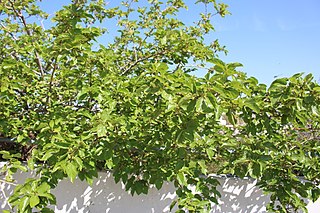
Morus alba, known as white mulberry, common mulberry and silkworm mulberry, is a fast-growing, small to medium-sized mulberry tree which grows to 10–20 m (33–66 ft) tall. It is generally a short-lived tree with a lifespan comparable to that of humans, although there are some specimens known to be more than 250 years old. The species is native to China and India and is widely cultivated and naturalized elsewhere.
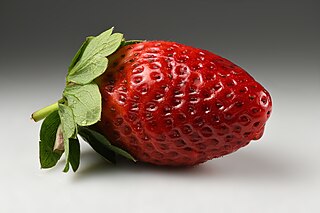
The garden strawberry is a widely grown hybrid species of the genus Fragaria in the rose family, Rosaceae, collectively known as the strawberries, which are cultivated worldwide for their fruit. This is appreciated for its aroma, bright red colour, juicy texture, and sweetness. It is eaten either fresh or in prepared foods such as jam, juice, pies, ice cream, milkshakes, and chocolates. Artificial strawberry flavourings and aromas are widely used in commercial products. Botanically, the strawberry is not a berry but an aggregate accessory fruit; each apparent 'seed' on the outside of the strawberry is actually an achene, a botanical fruit with a seed inside it.

Fragaria virginiana, known as Virginia strawberry, wild strawberry, common strawberry, or mountain strawberry, is a North American strawberry that grows across much of the United States and southern Canada. It is one of the two species of wild strawberry that were hybridized to create the modern domesticated garden strawberry.

Fragaria vesca, commonly called the wild strawberry, woodland strawberry, Alpine strawberry, Carpathian strawberry or European strawberry, is a perennial herbaceous plant in the rose family that grows naturally throughout much of the Northern Hemisphere, and that produces edible fruits.

Fragaria chiloensis, the beach strawberry, Chilean strawberry, or coastal strawberry, is one of two species of wild strawberry that were hybridized to create the modern garden strawberry. It is native to the Pacific Ocean coasts of North and South America.

Trichosanthes cucumerina is a tropical or subtropical vine. Its variety T. cucumerina var. anguina raised for its strikingly long fruit. In Asia, it is eaten immature as a vegetable much like the summer squash and in Africa, the reddish pulp of mature snake gourd is used as an economical substitute for tomato. Common names for the cultivated variety include snake gourd, serpent gourd, chichindapadwal and Snake Tomato.

Rubus saxatilis, or stone bramble, is a species of bramble widespread across Europe and Asia from Iceland and Spain east as far as China. It has also been found in Greenland.
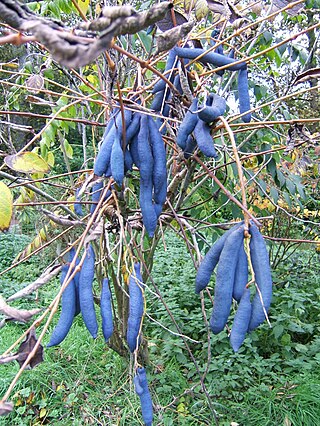
Decaisnea Hook.f &Thomson, known commonly as dead man's fingers, blue bean plant, or blue sausage fruit, is a genus of flowering plants in the family Lardizabalaceae. It is native to eastern Asia, from China west to Nepal and south to Myanmar.

Rubus armeniacus, the Himalayan blackberry or Armenian blackberry, is a species of Rubus in the blackberry group Rubus subgenus Rubus series Discolores Focke. It is native to Armenia and northern Iran, and widely invasive elsewhere. Both its scientific name and origin have been the subject of much confusion, with much of the literature referring to it as either Rubus procerus or Rubus discolor, and often mistakenly citing its origin as western European. Flora of North America, published in 2014, considers the taxonomy unsettled, and tentatively uses the older name Rubus bifrons.

Prunus tomentosa is a species of Prunus native to northern and western China, Korea, Mongolia, and possibly northern India. Common names for Prunus tomentosa include Nanjing cherry, Korean cherry, Manchu cherry, downy cherry, Shanghai cherry, Ando cherry, mountain cherry, Chinese bush cherry, and Chinese dwarf cherry.

Cypripedium macranthos, the large-flowered cypripedium, is a species of orchid. It is native to Russia and East Asia.

Paeonia anomala is a species of herbaceous perennial flowering plant in the family Paeoniaceae. This peony is ½–1 m high, with a thick irregular taproot and thin side roots. The deeply incised leaves have leaflets which are themselves divided in fine segments. It flowers in early summer, almost always with only one fully developed flower per stem, usually magenta-red or more rarely, pink or white. The species occurs in a zone between northern European Russia and northern Mongolia and south to the Tien Shan Mountains.

The breeding of strawberries started with the selection and cultivation of European strawberry species in western Europe in the 15th century while a similar discovery and cultivation occurred in Chile. The most commonly consumed strawberry species in modern times is the garden strawberry, a species derived from hybridization of two other species, with the scientific name Fragaria × ananassa, but there are many species of strawberries, several others of which are cultivated to some extent. The strawberry species fall into several different genetic types, based on their number of chromosomes. Strawberry growers have employed many breeding techniques, starting with traditional plant breeding and then moving on to molecular breeding and genetic engineering in the 20th century.

Clematis orientalis is a deciduous vine or scrambling shrub in the buttercup family Ranunculaceae, that originates from Asia and Central Europe. It was brought to the United States as an ornamental plant but escaped cultivation leading to its classification as a noxious weed in some states. Common names for C. orientalis include Chinese clematis, Oriental virginsbower, orange peel, and orange peel clematis.
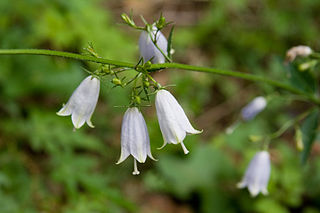
Adenophora triphylla, also known as Japanese lady bell, is one of the 62 species of Adenophora. It is a flowering plant in the family Campanulaceae that is distributed mainly over the Korean Peninsula, Japan, and China.
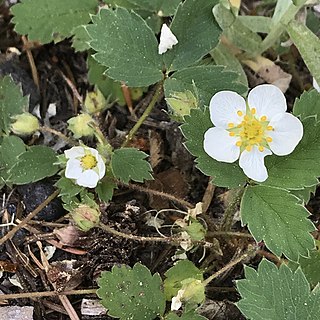
Fragaria cascadensis is a species of strawberry found in the Cascades Mountains described in 2012. The vernacular name Cascade strawberry was suggested by the describing author.
Fragaria pentaphylla is a tetraploid species of wild strawberry native to China. In Chinese, it is called the "five-leaf strawberry".

Berberis bealei, also known as leatherleaf mahonia, Beale's barberry, is a species of evergreen shrub native to mainland China. The species has been regarded as the same species as Berberis japonica, native to Taiwan, but the two differ consistently in certain floral and leaf characters. Both species are widely cultivated in many countries as ornamentals. Berberis bealei has reportedly escaped cultivation and become established in the wild in scattered places in the south-eastern United States from Arkansas to Florida to Delaware.

Rubus tricolor is an evergreen prostrate shrub, native to southwestern China. Leaves are dark green above, pale green below, and stems have red bristles. It has white flowers in summer and edible red fruit. It grows approximately 0.3 m (0.98 ft) high and usually forming a vigorously spreading, dense mat. In cultivation, it is mainly used as groundcover. Common names include Chinese bramble, groundcover bramble, creeping bramble, Korean raspberry, Himalayan bramble, and groundcover raspberry. In Chinese, it is called 三色莓.




















